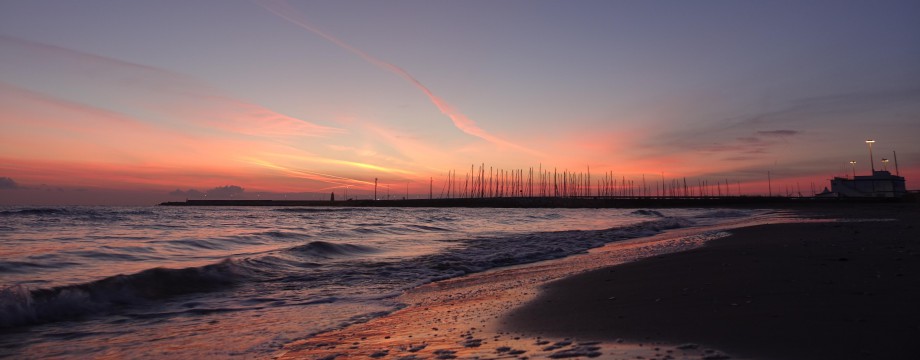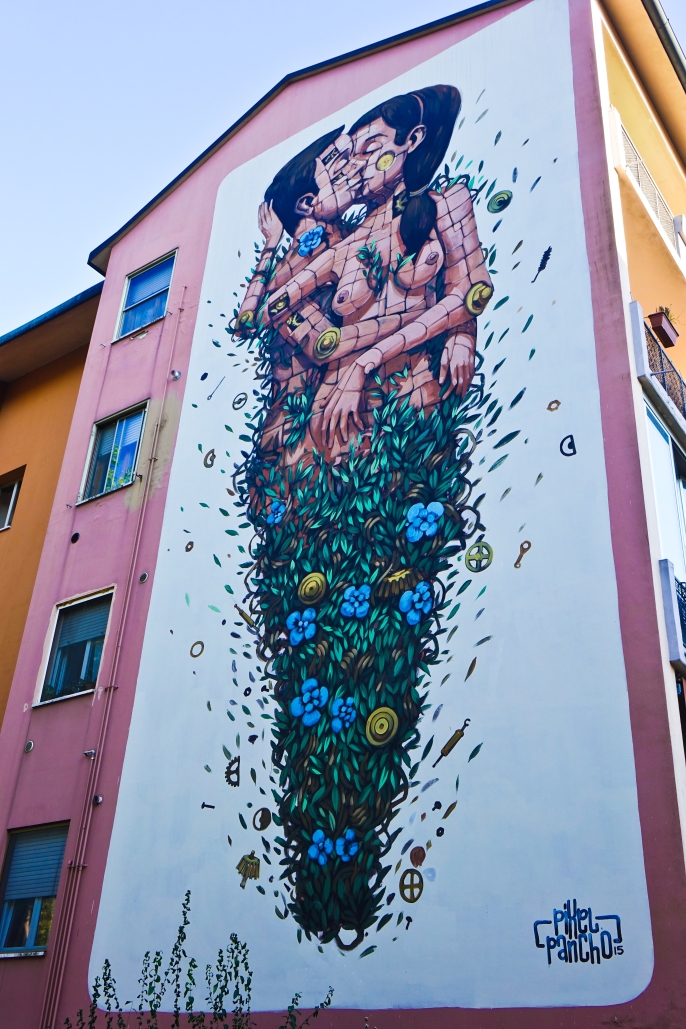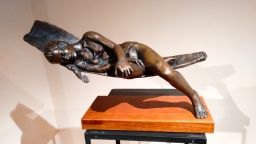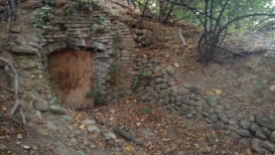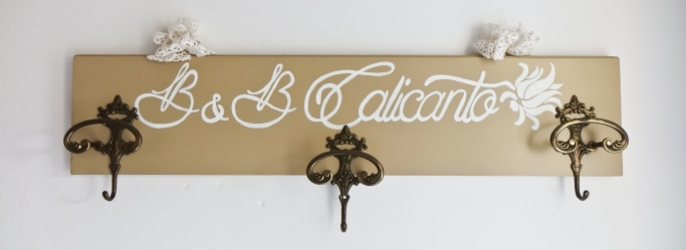Buongiorno a tutti!
How are you all? It feels like ages since the blog tour- I feel like I should go back for a refresher! So, I’ve talked about places to stay, places to eat and food/wine production, and the city of Forlì, but we also managed to add in a few other activities and cities to our agenda that were totally ‘up my alley’: art, exhibitions, sculptures, nature and a million and one photography and drawing opportunities!
See flamingos at the Parco del Delta del Po
Did you know there were wild flamingos living in Italy?! I didn’t! I wouldn’t have believed it had I not seen it with my own eyes. They fly up from Africa and ‘hang out’ in the Parco del Delta del Po as a stop-over to other climes but they have been known to stay for much of the year. We had a lovely boat trip up the river for a spot of bird watching. As soon as we started off in the boat a massive heron swooped over the river in front of us above a cormorant who was demonstrating his wing drying technique to us.
Our very knowledgeable English-speaking guide, Andrea, provided us with binoculars, pointed us in the direction of the local wildlife and gave us a commentary of the birds and plants that can be found there as well as the history of the park.



FLAMINGOS!!!!!!!!!!!!!!!!!!!!!!!!!!!!!!!!!!!!!!!!!!!
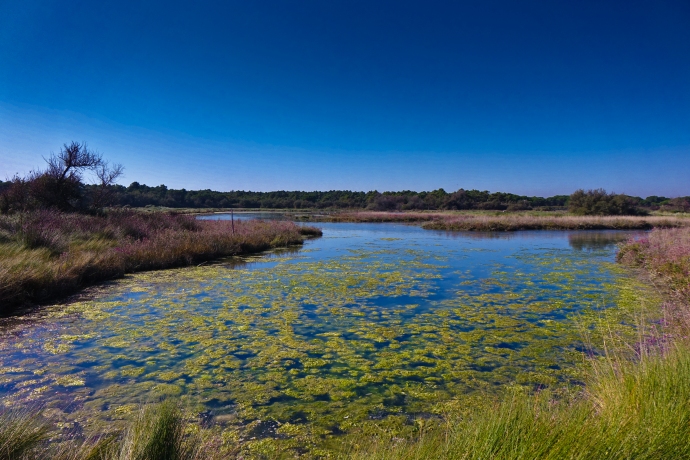
I could just spend all day on this river. If I lived in the area, I’d be permanently out there on a canoe with my camera. What makes it so interesting to photograph were these weird little houses on stilts with fishing nets. They’re called “casoni” in the park, but elsewhere in Italy they’re known as trabucchi. It’s the lazy mans way of catching fish. You basically sit on the deck with a beer looking at flamingos, lower the net into the water and wait for a few minutes, raise the net and voila, you have fish (sometimes).

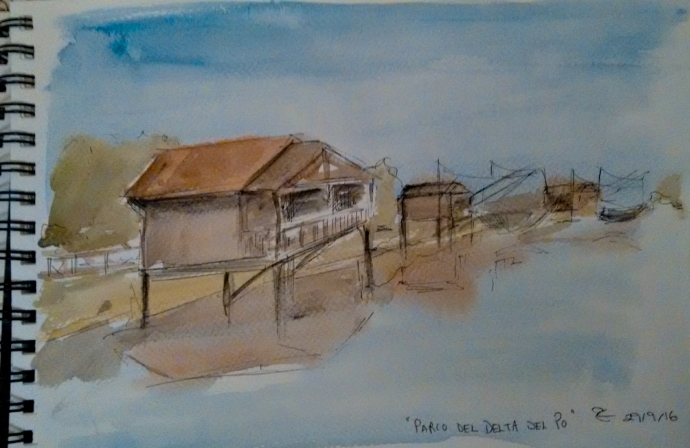
I’m trying to get as much sketching done as possible at the moment – my theory is that if I’m painting or drawing something every day, I’m going to improve quickly… we’ll see! Anyway, this was my very quick 10 minute watercolour sketch of the casoni.
The park office itself is very geared towards education, particularly children, where you can learn about how ox-bows are created and how the local water pumps work (the water pumps are essential to the area as a lot of the land in the area is actually lower than sea level). They also have ‘The Magic Box’ – a sort of virtual reality room which makes you feel like you’re in a lift and where you can navigate through the different strata of the Earth’s crust and learn about them as you go. It’s very clever; it really does make you feel like you’re in a lift!
Ravenna Street Art by bike
One of my other favourite activities of our blog tour was a bike trip to see Ravenna’s Street Art led by our guide Marco Miccoli who organises a Street Art Festival which takes place every September. I’ve never seen such an array of impressive murals before. There are a lot to see and you can find guides and hire bikes at the tourist information office in Piazza San Francesco. The locals have a healthy respect for the art and we didn’t see any of them painted over. It’s a beautiful way of giving a new lease of life to boring old buildings though I think there’s been some mixed reviews from the residents! This was one of my favourites…

There is such an array of styles and techniques – not just the more typical ‘spray paint’ variety. It’s certainly worth a look at and it’s all free!
Learn how to make a mosaic
Ravenna is famous for its mosaics. It has an incredibly high percentage of the world’s mosaics and they are everywhere. Have a look at one of my previous posts on Ravenna to check some of them out. Our bike tour took us past Koko Mosaico where we saw some mosaic artists in action. I really fancy doing some mosaics – they run courses one a month for a week. I’d love to give it a go! These are some of the mosaics that were on show at Koko Mosaico…
Visit the ID Dante exhibition
There’s not much time left to see this exhibition – it’s in the Biblioteca di Storia Contemporanea “Alfredo Oriani” and it closes on the 23rd October so if you’re in the area, get a move on! The exhibition shows the works of 33 artists all with a common theme: Dante, the author of the Divine Comedy. The classic image of Dante (check out the Wiki link above to see it) is one where he seems to be wearing a red night shirt with matching nightcap adorned with a sort of leafy halo (as you may be able to tell, I haven’t studied Dante or the Divine Comedy but from a novice perspective, that’s his image and it’s a well known one across Italy!). This exhibition had artists interpreting Dante’s portrait in their own style and using their own techniques. What a great idea – providing a common theme and seeing how different people interpret it. Seeing and hearing about the artwork was fascinating. I quite fancy having a go at Dante’s portrait myself now!
And why Dante? Dante is more associated with Florence but in fact, he had a big presence in Ravenna. Ravenna is where he died, his tomb is there (though I think there’s some question mark as to whether his body is?!). This project was designed to bring his presence in Ravenna more to the forefront. Here are my favourites from the exhibition. Guess which one of them gives me the creeps and makes my eyes hurt?
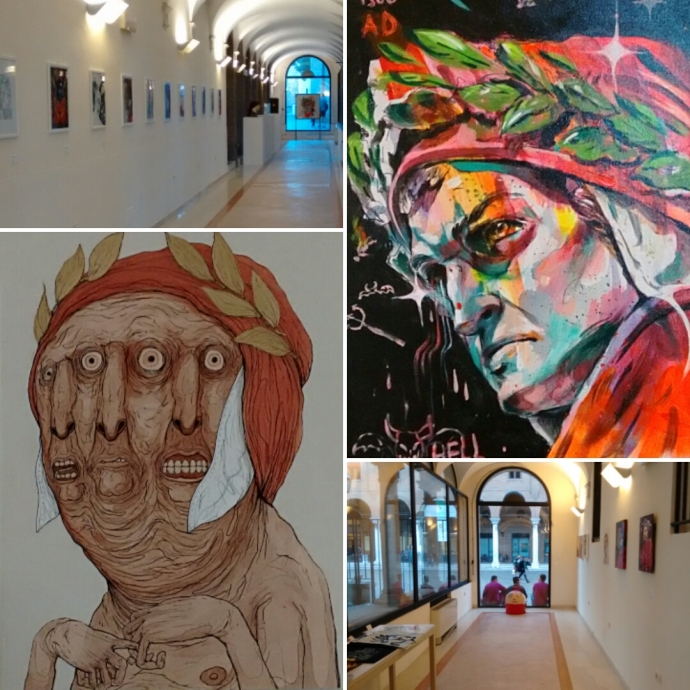
Cesena
Our final destination for the Blog Tour was Cesena. It was the first time I’d been to Cesena and I have to say, it’s my favourite of the cities we visited, mainly because it seems to be able to combine a ‘hip and happening’ vibe with quaint cobble-stoned streets! Cesena is characterised by the imposing ‘Rocca Malatestiana’ a fortress built by the Malatesta family (the governing family of the region between 1295 and 1500).
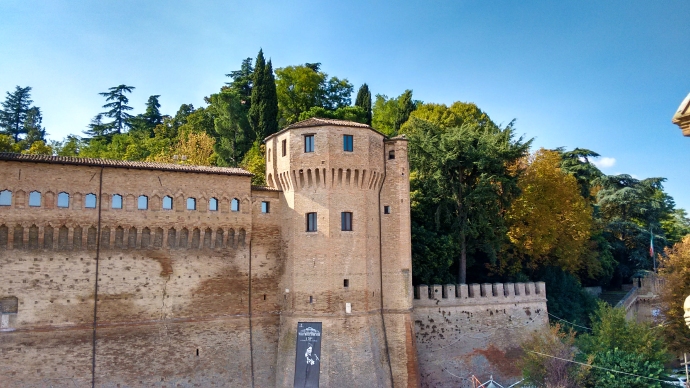
This is the Rocca Malatestiana. I still laugh when I think of the name of this family. “Malatesta”, the name of the family, sounds a lot like “mal di testa” when said quickly. “Mal di testa” means headache. During one tour of a castle years ago in Gradara, also inhabited by this family, I was struggling for ages to understand how headaches had such a prominent part to play in the history of the castle…
The city was surrounded by a wall, much of which still exists today and was designed by Leonardo Da Vinci. I was struck by how unimpressive the wall was – I mean, even I could have scaled it I think! However, it emerged that it was once surrounded by a moat and it rose further in my esteem when I learnt it was in the shape of a scorpion. Cesena is also the home to the Biblioteca Malatestiana which was the first municipal library in Italy and has been granted “Memory of the World” status by UNESCO for the building itself and for the books it contains. The old part of the library hasn’t changed from when it was built almost 600 hundred years ago and it’s still possible to visit. To best explore Cesena, it’s a good idea to do it by bike. Everything is flat so it’s a good way to discover the city. There is an amazing free online audio guide that you can listen do on your way around.

Our first stop on our bike tour was the studio of Leonardo Lucchi in Piazza del Popolo where there is also a permanent exhibition of his sculptures. His sculptures are brilliant – the work is mainly females in bronze with a sort of characteristic ‘balancing’ component which makes you wonder how on earth the sculpture is staying upright. All of them have a real delicacy about them. Here are some of my favourites. The exhibition is free so pop in if you’re in Cesena…
Then we went outside of the city walls to follow the river
But my favourite part of the Cesena tour was inside the city walls. Cesena has all these quaint pretty painted houses and cobbled walkways. It really is a lovely city.
We planned our trip to Cesena perfectly in time for their International Street Food Festival which has been going for 9 years or so. I was so thrilled! In Italy, you get a choice of Italian restaurants or Italian restaurants, or sometimes Italian restaurants! I mean, I love Italian food so it’s not a problem, but sometimes I just hanker after food that’s not Italian. So I was ecstatic to be able to eat a burrito (Mexican food for the Italian’s reading this!). I haven’t had one for over 3 years! And there was curry… mmmm curry! It’s definitely worth coming to Cesena just for this festival to be honest. The chefs are from all around the world and cook their own traditional food. Brilliant!
I could sit and have a drink in Piazza del Popolo, the main square in Cesena, for hours. In fact, we did. I managed to fit a drawing in too!

So that about sums up my Blog Tour week. I had the best time with some lovely fellow bloggers who were incredibly patient with my Italian (I become monosyllabic after about 9pm) and I’m so pleased I had this opportunity to explore the area “off the beaten track” and meet some wonderful characters in the process.
Have a look at what my fellow bloggers had to say too:
Meanwhile, as ever, I am always available to be wined and dined on a blog tour in any hot, sunny country, perhaps by a beach (Maldives: You need me!). For any questions about what we did or for any corrections, drop me a line in the comments 🙂
A presto,
x
